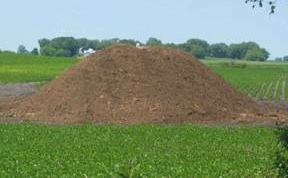
Features
Applications
Beef
Environment
Environment Protection
Protection
Sustainability
Guidelines for stockpiling manure
June 23, 2016 by Press release

June 23, 2016, Darke County, OH – If you are considering stockpiling manure this summer, choosing the right location and following best management practices can decrease the chance of polluting waters.
Please note, stockpiling is not a substitute for adequate manure storage, but can be used when conditions are not suitable for land application.
Manure stockpiles must be solid manure with bedding (minimum of 20 percent solids) or dry poultry manure and should be located in or near the field that the manure is to be applied. Stockpiles cannot be stored for more than eight months. It is recommended that a 100-foot temporary vegetative buffer be placed around the pile if the manure will be stockpiled for more than four months. Also, consider covering the manure, to minimize leachate from rainfall or snow.
The stockpile should be located on soils that are deep to bedrock (greater than 40 inches) and not on soils with rapid or very rapid permeability. They should not be located in areas that occasionally or frequently flood, on hydric soils or on slopes greater than six percent.
Recommended minimum setback distances for manure stockpiles include:
- 75 feet from overhead or buried utilities
- 500 feet from residences
- 300 feet from private wells
- 300 feet from ponds and lakes
- 300 feet from streams, grassed waterways, and field surface drains
- 300 feet from tile inlet or broken tile
- 1500 feet from any public surface drinking water intakes.
Stockpiles should be inspected after rain events of 0.5-inches or more to check for leachate ponding or runoff. They should also be monitored for flies, beetles and other pests if stored longer than one week.
Records should be kept for each stockpile and include:
- Location map of the stockpile
- Date and volume of stockpile
- Nitrogen and phosphorus content of the manure
- Date(s) the stockpile was inspected (after rainfall and for pests)
- Date stockpile was land applied and the number of acres applied to
After the manure stockpile has been removed from the field, consider planting a vegetative cover on the site to recycle the nutrients left if site conditions allow. Also, for cropland areas, it is recommended that the same site not be used again to stockpile manure for at least one full growing season.
Manure stockpile requirements are defined in the Natural Resources Conservation Service (NRCS) Waste Utilization Standard 633 available at www.darkeswcd.com. Please note, other regulations may apply to manure originating from ODA permitted facilities or handled by ODA certified livestock managers. For more information on manure management, please contact the Darke SWCD office at 937-548-1752.